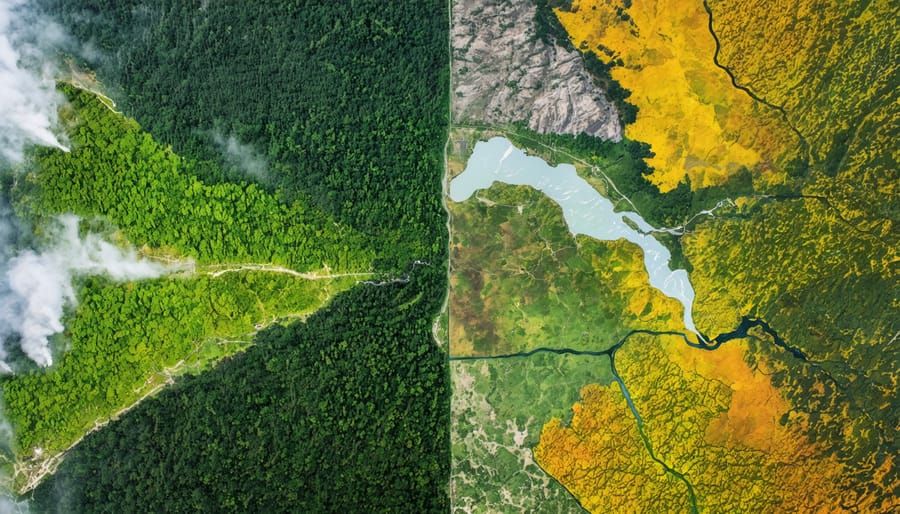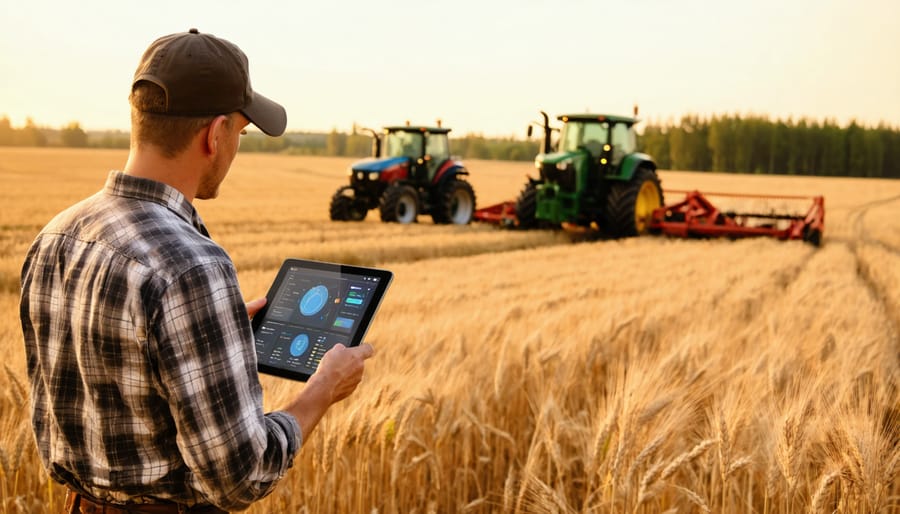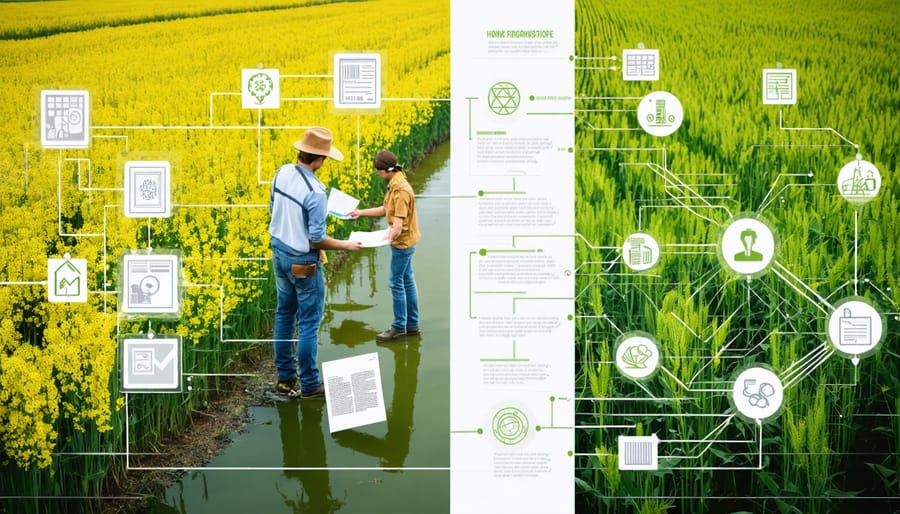Alberta’s vast natural resources power Canada’s economic engine, with over $91.7 billion in annual revenue generated from oil, minerals, timber, and agricultural lands. Through sustainable resource management practices, the province stewards 661,848 square kilometers of resource-rich territory, including the world’s third-largest proven oil reserves, 11 million hectares of agricultural land, and 38 million hectares of forests. These resources directly employ over 415,000 Albertans while supporting indigenous communities, driving innovation in clean technology, and maintaining Canada’s position as a global leader in responsible resource development. From the boreal forests in the north to the fertile prairies in the south, Alberta’s diverse landscape harbors a complex network of interconnected resources that demand careful balance between economic development and environmental preservation. Understanding these resources – their distribution, sustainable extraction methods, and long-term management strategies – proves crucial for farmers, industry professionals, and communities working to secure Alberta’s prosperous future while protecting its natural heritage.
Alberta’s Agricultural Gold: Our Soil Resources
Understanding Alberta’s Soil Zones
Alberta’s soil landscape is divided into six distinct zones, each offering unique characteristics for agricultural production. The Black soil zone, stretching through central Alberta, contains some of the province’s most fertile land, with rich organic matter content reaching up to 10%. This zone supports diverse crop production and has historically been the backbone of Alberta’s grain farming.
Moving northward, the Dark Gray and Gray Wooded zones present slightly more acidic conditions but still maintain good agricultural potential when properly managed. These soils typically require additional nutrients and careful pH management to achieve optimal crop yields.
The Brown and Dark Brown soil zones, prevalent in southern Alberta, feature lower organic matter content but excel in growing drought-resistant crops. Despite receiving less annual precipitation, these zones have proven remarkably productive for wheat and other cereal crops when combined with modern moisture conservation techniques.
The Peace River region showcases the unique Solonetzic soils, which despite their challenging structure, can be highly productive with appropriate management practices. Local farmers have developed specialized techniques, including deep tillage and careful water management, to maximize these soils’ potential.
Understanding your specific soil zone is crucial for successful farming in Alberta, as each type requires different management approaches and crop selections. Regular soil testing and working with regional agronomists can help determine the best practices for your particular location.
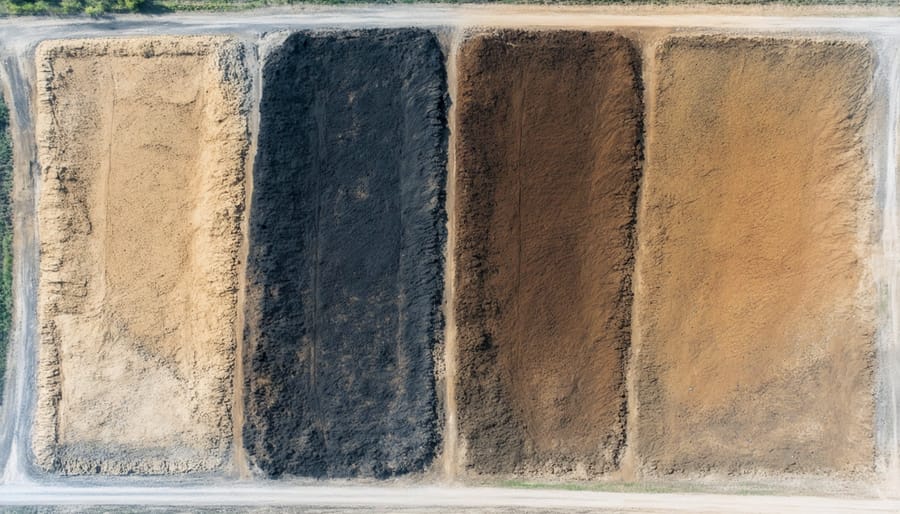
Soil Health Management Practices
Alberta’s farmers are leading the way in innovative soil health management practices that protect and enhance this vital natural resource. Many producers have adopted no-till farming methods, which minimize soil disturbance and help maintain organic matter levels. Cover cropping has become increasingly popular, with farmers planting diverse species like clover, rye, and legumes during off-seasons to prevent erosion and naturally boost soil nutrients.
Crop rotation strategies specific to Alberta’s climate help break pest cycles and enhance soil structure. Local farmers typically rotate between cereals, oilseeds, and pulse crops, creating a balanced system that promotes long-term sustainability. These practices are crucial for improving soil quality while maintaining productive agricultural operations.
Many Alberta producers also incorporate livestock into their management systems through careful grazing practices. This approach helps cycle nutrients naturally and improves soil organic matter content. Regular soil testing and monitoring have become standard practice, allowing farmers to make informed decisions about amendments and management strategies.
The adoption of precision agriculture technology helps farmers target specific areas needing attention, reducing unnecessary inputs while maximizing soil health benefits. These combined practices demonstrate Alberta’s commitment to preserving and enhancing its valuable soil resources for future generations.
Water Resources: The Lifeblood of Alberta’s Agriculture

Irrigation Networks and Watershed Management
Alberta’s irrigation networks form the largest irrigation system in Canada, serving over 690,000 hectares of agricultural land. The province’s 13 irrigation districts, primarily concentrated in the southern region, have transformed semi-arid landscapes into productive farmland through efficient water management and distribution systems.
The backbone of this network consists of more than 8,000 kilometres of canals and pipelines, drawing water primarily from the Bow, Oldman, and South Saskatchewan River systems. Modern irrigation technologies, including pivot systems and drip irrigation, have helped farmers achieve water use efficiency rates of up to 85%, significantly higher than traditional flood irrigation methods.
Watershed management in Alberta follows an integrated approach, balancing agricultural needs with environmental conservation. Local watershed stewardship groups work alongside farmers to implement best practices such as riparian buffer zones and wetland preservation. These efforts help maintain water quality while supporting agricultural productivity.
Recent innovations in irrigation management include real-time soil moisture monitoring and weather-based scheduling systems. Many Alberta farmers now use smart irrigation controllers that adjust water application based on actual crop needs and environmental conditions. This precision approach has led to water savings of 20-30% compared to conventional irrigation methods.
The province’s Water for Life strategy emphasizes sustainable water use in agriculture, promoting practices that conserve water while maintaining crop yields. Successful initiatives include the conversion of open canals to underground pipelines, reducing water loss through evaporation, and the implementation of return flow systems that capture and reuse irrigation runoff.
Looking ahead, Alberta’s irrigation networks continue to evolve with climate-smart technologies and sustainable management practices, ensuring long-term water security for agricultural communities.
Sustainable Water Use Practices
Alberta farmers have developed innovative approaches to water conservation that balance agricultural productivity with environmental stewardship. Drip irrigation systems have become increasingly popular across the province, reducing water usage by up to 40% compared to traditional sprinkler systems while maintaining crop yields. These systems deliver water directly to plant roots, minimizing evaporation and runoff.
Many Alberta producers have adopted soil moisture monitoring technologies, including sensors and weather stations, to optimize irrigation scheduling. This data-driven approach ensures crops receive water only when needed, preventing both under and over-irrigation. Local farmer Jim Henderson from Lethbridge County reports saving approximately 2.5 million litres of water annually since implementing these monitoring systems.
Water retention practices such as conservation tillage and cover cropping have shown remarkable success in the region. These methods improve soil structure and organic matter content, allowing fields to hold more moisture between rainfall or irrigation events. The Alberta Agriculture and Forestry department estimates that fields using these practices retain up to 25% more moisture than conventionally managed land.
Rainwater harvesting has emerged as another effective strategy, with many farms installing collection systems for their buildings and greenhouses. This stored water provides a sustainable source for livestock and supplemental irrigation during dry periods. Some operations have integrated constructed wetlands into their water management systems, which naturally filter and store water while creating wildlife habitat.
The Agricultural Water Management Program offers support to farmers implementing these sustainable practices, providing both technical expertise and potential funding assistance. Through community-based learning initiatives, successful water conservation strategies are shared among local producers, fostering a collaborative approach to resource management.
Forest Resources and Agroforestry Opportunities
Benefits of Shelterbelts and Windbreaks
Shelterbelts and windbreaks have transformed Alberta’s agricultural landscape, offering multiple benefits that extend well beyond basic wind protection. These strategic tree plantings create microclimates that enhance crop yields by up to 15% in adjacent fields, primarily by reducing moisture loss and protecting young plants from wind damage.
For livestock producers, shelterbelts provide essential protection during harsh Alberta winters, reducing animal stress and decreasing feed requirements by up to 25%. Cattle with access to shelter maintain better body condition and demonstrate improved reproductive success, translating to tangible economic benefits for farmers.
These living barriers play a crucial role in soil conservation, preventing wind erosion that annually threatens valuable topsoil. By reducing wind speeds by 50-80% in protected areas, shelterbelts help maintain soil structure and organic matter content, particularly important in Alberta’s prairie regions where wind erosion is a significant concern.
Water management benefits are equally impressive. Snow capture behind shelterbelts can increase spring soil moisture by up to 100mm, providing valuable water reserves for early-season crop growth. During summer months, reduced evaporation rates help maintain soil moisture levels, supporting crop resilience during dry periods.
Beyond the farm-level advantages, shelterbelts contribute significantly to local biodiversity. These green corridors provide habitat for beneficial insects, including pollinators and natural pest predators, while supporting native bird populations that aid in natural pest control.
Economic analysis shows that while establishment costs range from $2,000 to $3,500 per kilometre, the long-term returns through improved yields, reduced inputs, and enhanced property values typically offset initial investments within 7-10 years. Many Alberta farmers report additional income streams through sustainable wood harvesting and berry production from their mature shelterbelts.
For optimal results, local agricultural extension services recommend using a mix of native species like white spruce, green ash, and caragana, which are well-adapted to Alberta’s climate and provide year-round protection. Regular maintenance, including proper spacing and pruning, ensures these living infrastructure investments continue delivering benefits for generations to come.
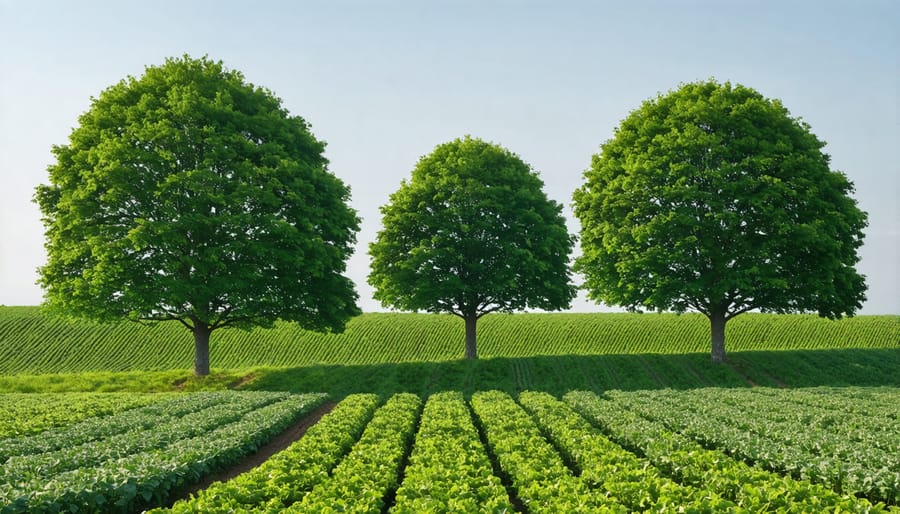
Mineral Resources and Sustainable Land Use
Land Reclamation for Agricultural Use
Alberta’s commitment to land reclamation following mining operations has created remarkable opportunities for agricultural development. Through careful planning and innovative techniques, previously mined lands are being transformed into productive farmland, benefiting both the environment and local farming communities.
The reclamation process typically begins with soil conservation during the initial mining phase. Topsoil and subsoil are carefully stripped, stored, and protected to maintain their biological properties. Once mining operations conclude, these soils are strategically replaced in layers that mirror natural soil profiles, creating a foundation for agricultural success.
Local farmers have reported impressive results from reclaimed lands. For instance, the Cardinal River area has seen successful conversions to grazing lands, where cattle now thrive on restored native grasslands. In the oil sands region near Fort McMurray, demonstration projects have shown that reclaimed lands can support various crops, including barley, alfalfa, and native grasses.
Key reclamation strategies include:
– Soil reconstruction with appropriate organic matter content
– Implementation of erosion control measures
– Strategic contouring to optimize drainage and moisture retention
– Establishment of cover crops to rebuild soil structure
– Regular soil testing and amendments as needed
The Alberta government’s reclamation certification process ensures that restored lands meet strict agricultural productivity standards. Companies must demonstrate that reclaimed areas can sustain agricultural activities for a minimum of five years before receiving certification.
Local agricultural extension services provide valuable support to farmers transitioning to reclaimed lands, offering guidance on soil management, crop selection, and sustainable farming practices. These services help ensure long-term success and optimal yields.
Community involvement plays a crucial role in successful reclamation projects. Regular consultations with local farmers help shape restoration plans, ensuring that reclaimed lands meet the practical needs of agricultural operations while supporting regional food security goals.
Through these coordinated efforts, Alberta continues to expand its agricultural land base while healing landscapes impacted by resource extraction, demonstrating that responsible resource development and agricultural prosperity can go hand in hand.
Alberta’s agricultural success relies heavily on the thoughtful integration of its abundant natural resources. By adopting a holistic approach to resource management, farmers across the province are demonstrating that productivity and sustainability can work hand in hand. The key lies in understanding how soil health, water conservation, and biodiversity interconnect to create resilient farming systems.
Looking ahead, the sustainable management of Alberta’s natural resources will become increasingly crucial. Climate variability and growing market demands require farmers to be both stewards of the land and efficient producers. Successful examples throughout the province show that when farmers implement integrated resource management strategies, they often see improved yields, reduced input costs, and enhanced soil fertility.
The agricultural community’s commitment to responsible resource use has already yielded promising results. From precision irrigation systems in Southern Alberta to soil conservation practices in the Peace Country, farmers are leading the way in innovative resource management. These efforts not only benefit individual operations but contribute to the long-term viability of Alberta’s agricultural sector.
For future generations of farmers, maintaining this balance between production and conservation will be essential. By sharing knowledge, implementing best practices, and embracing new technologies, Alberta’s agricultural community can continue to thrive while preserving its natural resources. Support from agricultural extension services, research institutions, and farmer-led initiatives provides the foundation for this collaborative approach.
As we move forward, the success of Alberta’s agricultural sector will depend on our ability to manage resources wisely, adapt to changing conditions, and maintain the health of our natural systems. Through continued cooperation and commitment to sustainable practices, we can ensure that Alberta remains a leader in responsible agricultural production.

